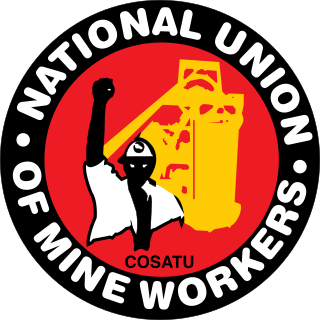Related Research Articles
Lonmin plc, formerly Lonrho plc, was a British producer of platinum group metals operating in the Bushveld Complex of South Africa. It was listed on the London Stock Exchange. Its registered office was in London, and its operational headquarters were in Johannesburg, South Africa.
Driefontein is the Driefontein Mine in the West Witwatersrand Basin mining field. The West Wits field was discovered in 1931 and commenced operations with Venterspost Gold Mine in 1939. In 1952, the West Driefontein mine is opened. In 1968, Kloof mine commences operations. In 1972, East Driefontein opens. In 1981, consolidation starts. In 1999, Gold Fields took control of the combined East and West Driefontein mines and merged them starting 2000 with Venterspost, Libanon, Leuudoorn and Kloof mines. In 2010, the current Kloof-Driefontein Complex, comprising KDC East and KDC West, is formed.
Anglo American Platinum Limited is the world's largest primary producer of platinum, accounting for about 38% of the world's annual supply.

Gold Fields Limited is one of the world's largest gold mining firms. Headquartered in Johannesburg, South Africa, the company is listed on both the Johannesburg Stock Exchange (JSE) and the New York Stock Exchange (NYSE). The firm was formed in 1998 with the amalgamation of the gold assets of Gold Fields of South Africa Limited and Gencor Limited. The company traces its roots back to 1887, when Cecil Rhodes founded Gold Fields of South Africa Limited. As of 2019, Gold Field was the world's eighth-largest producer of gold.

The National Union of Mineworkers (NUM) is a mainly mining industry related trade union, an organisation of workers with common goals through organised labour, in South Africa. With a membership of 300,000 as of 2014, it is the largest affiliate of the Congress of South African Trade Unions (COSATU).

Mining in South Africa was once the main driving force behind the history and development of Africa's most advanced and richest economy. Large-scale and profitable mining started with the discovery of a diamond on the banks of the Orange River in 1867 by Erasmus Jacobs and the subsequent discovery and exploitation of the Kimberley pipes a few years later. Gold rushes to Pilgrim's Rest and Barberton were precursors to the biggest discovery of all, the Main Reef/Main Reef Leader on Gerhardus Oosthuizen's farm Langlaagte, Portion C, in 1886, the Witwatersrand Gold Rush and the subsequent rapid development of the gold field there, the biggest of them all.
Aquarius Platinum plc is a Bermuda-registered and headquartered mining business.
The mineral industry of Africa is the second-largest mineral industry in the world. Africa is the second largest continent, with 30.37 million square kilometre of land, which implies large quantities of resources. With a population of 1.4 billion living there. For many African countries, mineral exploration and production constitute significant parts of their economies and remain keys to economic growth. Africa is richly endowed with mineral reserves and ranks first in quantity of world reserves of bauxite, cobalt, industrial diamond, phosphate rock, platinum-group metals (PGM), vermiculite, and zirconium.

Mining is the biggest contributor to Namibia's economy in terms of revenue. It accounts for 25% of the country's income. Its contribution to the gross domestic product is also very important and makes it one of the largest economic sectors of the country. Namibia produces diamonds, uranium, copper, magnesium, zinc, silver, gold, lead, semi-precious stones and industrial minerals. The majority of revenue comes from diamond mining. In 2014, Namibia was the fourth-largest exporter of non-fuel minerals in Africa.
Blyvooruitzicht is a gold mine and gold-mining village in Gauteng, South Africa. It is situated about 5 km south of the centre of Carletonville and 80 km westwards from Johannesburg.
The African Mine Workers' Strike was a labour dispute involving mine workers of Witwatersrand in South Africa. It started on 12 August, 1946 and lasted approximately a week. The strike was attacked by police and over the week, at least 1,248 workers were wounded and at least 9 killed.
There are different methods by which gold mining companies are ranked. One is by their annual production. Another is by their cash cost per ounce, that is, how much money it costs them to mine the gold. Since gold prices are the same everywhere, companies with lower costs per ounce make more profit. The most common method lists by market capitalization which considers the total value of capital holdings by that company. Also considered when comparing companies is their market capitalization per ounce of gold equivalent which takes the market value and total reserves and resources for each company as well as the price of gold into consideration. The figures for each company can be used to determine the value the stock market gives to each company's reserves on an ounce to ounce basis.

Impala Platinum Holdings Limited or Implats is a South African holding company that owns several companies which operate mines that produce platinum and platinum group metals, as well as nickel, copper and cobalt. Its most significant mine is the Impala mine in the North West province of South Africa. The company also owns or has interest in the Two Rivers mine and the Marula mine in the South Africa Bushveld Igneous Complex and the Mimosa mine and Zimplats in Zimbabwe, as well as the Impala Refining Services which smelts and refines metals for other companies. In December 2019, Impala Canada was formed, owned by the holding company, out of the acquisition of North American Palladium and its mine in Ontario, Canada.
Marikana, formerly known as Rooikoppies, is a town in the Rustenburg local municipality, Bojanala Platinum District Municipality district in the North West province of South Africa.

The Marikana massacre was the killing of thirty-four miners by the South African Police Service (SAPS) on 16 August 2012 during a six-week wildcat strike at the Lonmin platinum mine at Marikana near Rustenburg in South Africa's North West province. The massacre constituted the most lethal use of force by South African security forces against civilians since the Soweto uprising in 1976 and has been compared to the 1960 Sharpeville massacre.

The Association of Mineworkers and Construction Union (AMCU) was formed in Mpumalanga, South Africa, in 1998 as a breakaway faction of the COSATU-affiliated National Union of Mineworkers (NUM). It was formally registered as a union in 2001. According to Mining Weekly, the union sees itself as distinct from NUM in that it is "apolitical and noncommunist".

The Workers and Socialist Party (WASP) is a Marxist and Trotskyist political party in South Africa affiliated to International Socialist Alternative.

The Driefontein mine is a large mine located in the northern part of South Africa in Gauteng. Driefontein is an important gold producer and represents one of the largest uranium reserves in South Africa having estimated reserves of 238 million tonnes of ore grading 0.0053% uranium.
On 15 November 2014 workers at South Africa's major platinum producers – Anglo American Platinum, Impala Platinum, and Lonmin – went on strike demanding that wages be immediately doubled. However, after five months of striking they settled for a more modest pay increase spread over three years. It was the longest and most expensive strike in South African history.

Sibanye-Stillwater is a multinational mining and metals processing Group with a diverse portfolio of mining and processing operations and projects and investments across five continents. The Group is also one of the foremost global PGM auto catalytic recyclers and has interests in leading mine tailings retreatment operations.
References
- ↑ "Uranium in South Africa". wise-uranium.org. 2012. Retrieved 2013-07-16.
- ↑ Sibanye-Stillwater "Company Announcements", Sibanye-Stillwater, November 29, 2012. Retrieved April 11, 2018.
- 1 2 3 Minto, Rob (2012-09-26). "SA strikes close AngloGold Ashanti". Financial Times. Retrieved 2022-10-19.
- 1 2 Van Wyngaardt, Megan (2012-09-25). "Gold Fields says KDC West strike spreads to Beatrix". Engineering News. Retrieved 2022-10-19.
- 1 2 Njanji, Susan (2012-10-03). "Gold Fields evicts workers as mining strike spreads". The Mail & Guardian. Retrieved 2022-10-19.
- 1 2 Lakmidas, Sherilee (2012-10-19). "Gold Fields strike ends, 1,500 sacked as South Africa trouble simmers". Reuters. Retrieved 2022-10-19.
- ↑ Hlongwane, S.; Patel, K. (2012-10-18). "Searching for workers, and their representatives, at KDC West". Daily Maverick. Retrieved 2022-10-19.
- 1 2 "Gold Fields issues ultimatum". Sowetan. 2012-10-22. Retrieved 2022-10-19.
- ↑ Gold Fields (2012-10-15). "8,500 KDC East Employees Join Unlawful Strike". PR Newswire. Retrieved 2022-10-19.
- ↑ Lakmidas, Sherilee (2012-10-15). "South Africa strikes engulf Gold Fields' KDC operations". Reuters. Retrieved 2022-10-19.
- ↑ Gold Fields (2012-10-17). "Strike ends at Beatrix 1,2 and 3 shafts". PoliticsWeb. Retrieved 2022-10-19.
- ↑ "South Africa Gold Fields workers 'end strike'". BBC News. 2012-10-19. Retrieved 2022-10-19.
- ↑ "Gold Fields' KDC East ends 23-day strike". Miningmx. 2012-11-06. Retrieved 2022-10-19.